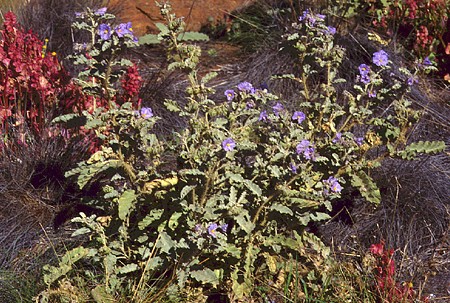
Synonymy
Solanum eardleyae Symon, J. Adelaide Bot. Gard. 4: 212; figs 83, 89 (1981)
T: Duffield Rocks, c. 91 km NE of Mt Davies Camp, S.A., 1 Oct. 1970, P.K. Latz 939; holo: NT; iso: AD ex ADW, CANB, MEL.
Description
Straggly, erect shrub to 2 m, rusty-green, rarely grey-green, densely pubescent with stellate hairs; prickles to 10 mm long, abundant on stems, petioles, peduncles and calyx, generally scattered elsewhere.
Leaves oblong-ovate; lamina mostly 5–10 cm long, 2–4 cm wide, sometimes larger, concolorous, undulate to shallowly lobed; petiole 1–2 cm long.
Inflorescence few–22–flowered; peduncle 1–2 cm long; rachis 3–10 cm long; pedicels 5–10 mm long. Calyx 8–13 mm long, enlarged in fruit; lobes narrowly triangular with linear apices, 5–10 mm long. Corolla rotate, 25–35 mm diam., purple. Anthers 4–5 mm long.
Berry globular, 10–15 mm diam., yellow, finally hard and bony. Seeds 1.5–2 mm long, light buff to light grey-brown.
Distribution and ecology
Restricted mainly to Musgrave and Everard Ranges and Mt Connor in Central Australia, usually occurring at the base of rock outcrops.
Relationships
Considered by Bean (2004) to be a member of the S. hystrix group of subgen. Leptostemonum.
Notes
According to North Australia Land Manager S. eardleyae has a life span of over 20 years, producing its first seeds within 1-3 years and is able to resprout from root suckers or rhizomes after fire.
Derivation of epithet
Named after Miss Constance M. Eardley, lecturer in taxonomy in the Botany Department, University of Adelaide, from 1933-1976. See www.anbg.gov.au/biography/eardley-constance.html
Selected specimens
N.T.: SE side of Mt Connor, A.C. Beauglehole 22854 (AD, CANB); Mulga Park Homestead, P.K. Latz 5044 (AD, DNA, NT). S.A.: between Ernabella and Mt Woodroffe, F.L. Hill & T.R.N. Lothian 707 (AD).
Plant status, if any
Conservation status as a plant of least concern in the
From the web
A fact sheet for this species can be downloaded from the SA eFlora site.



